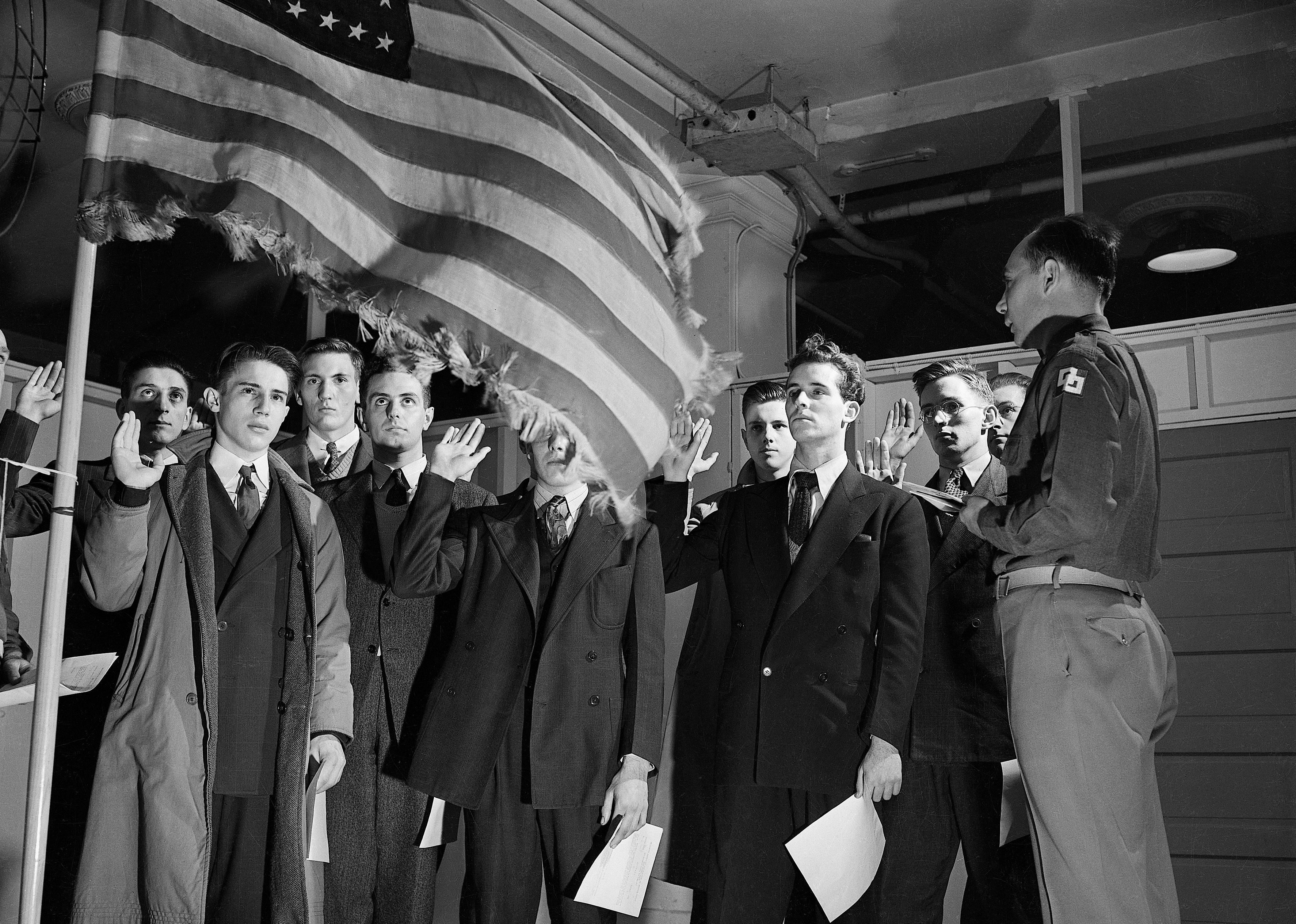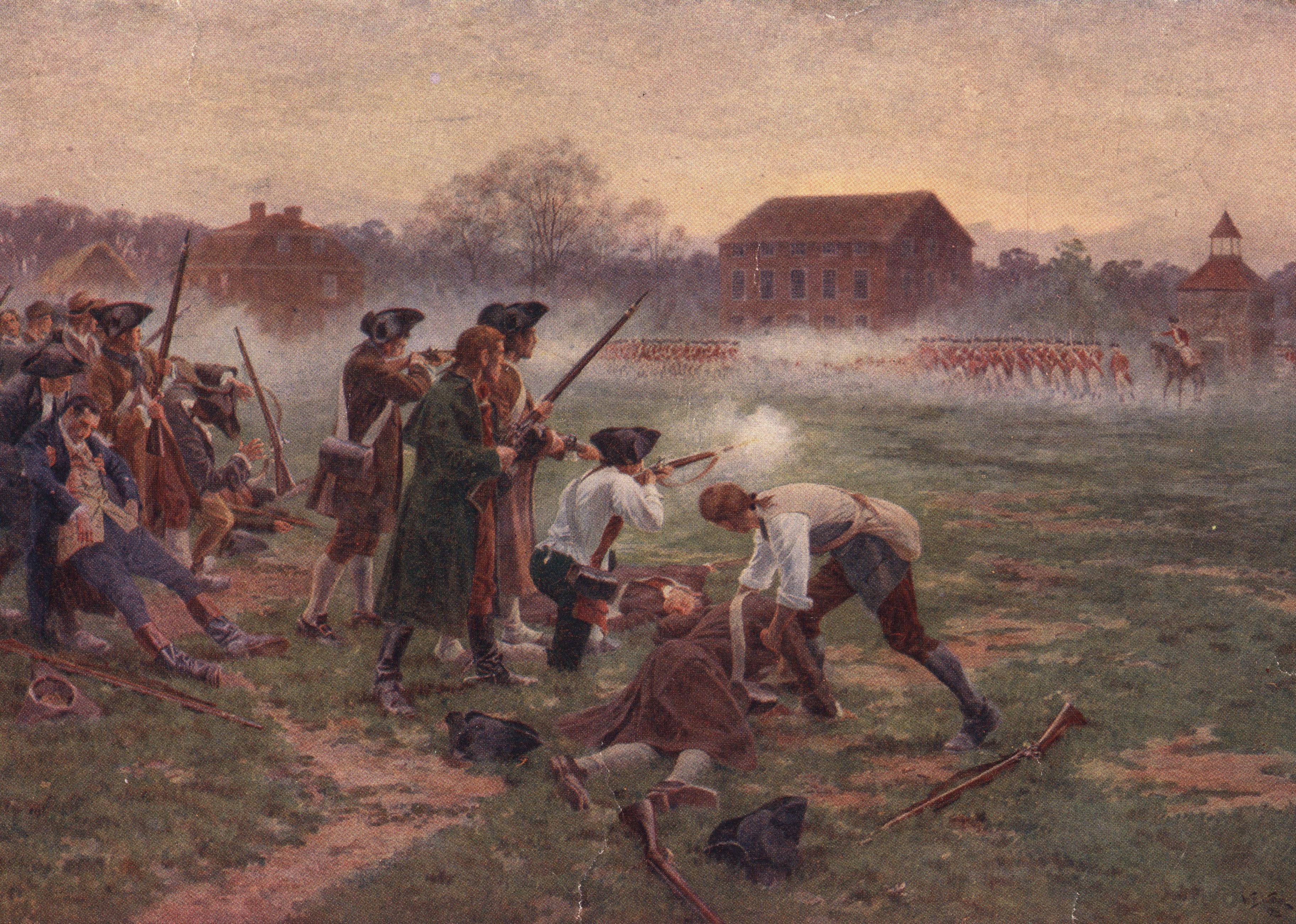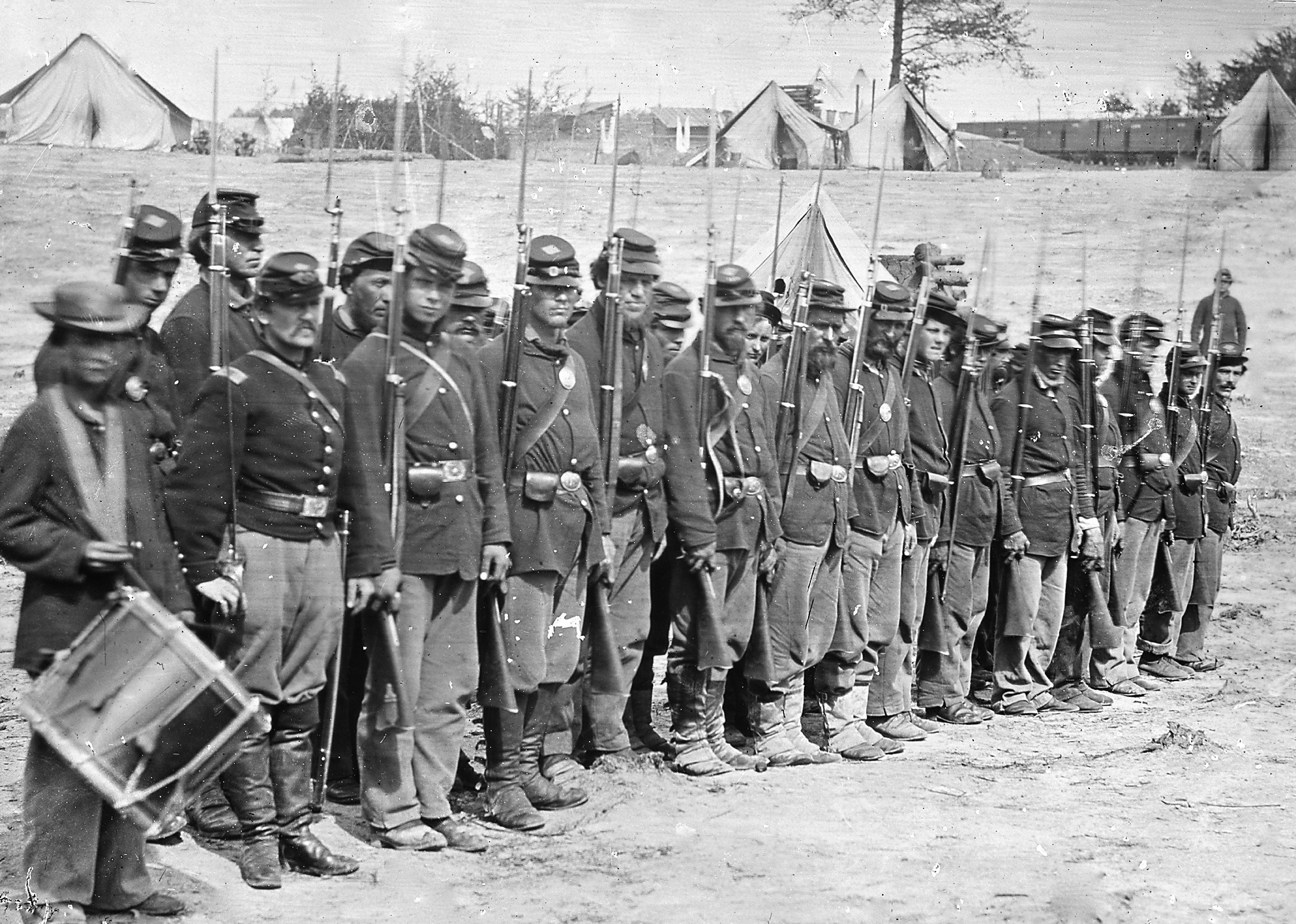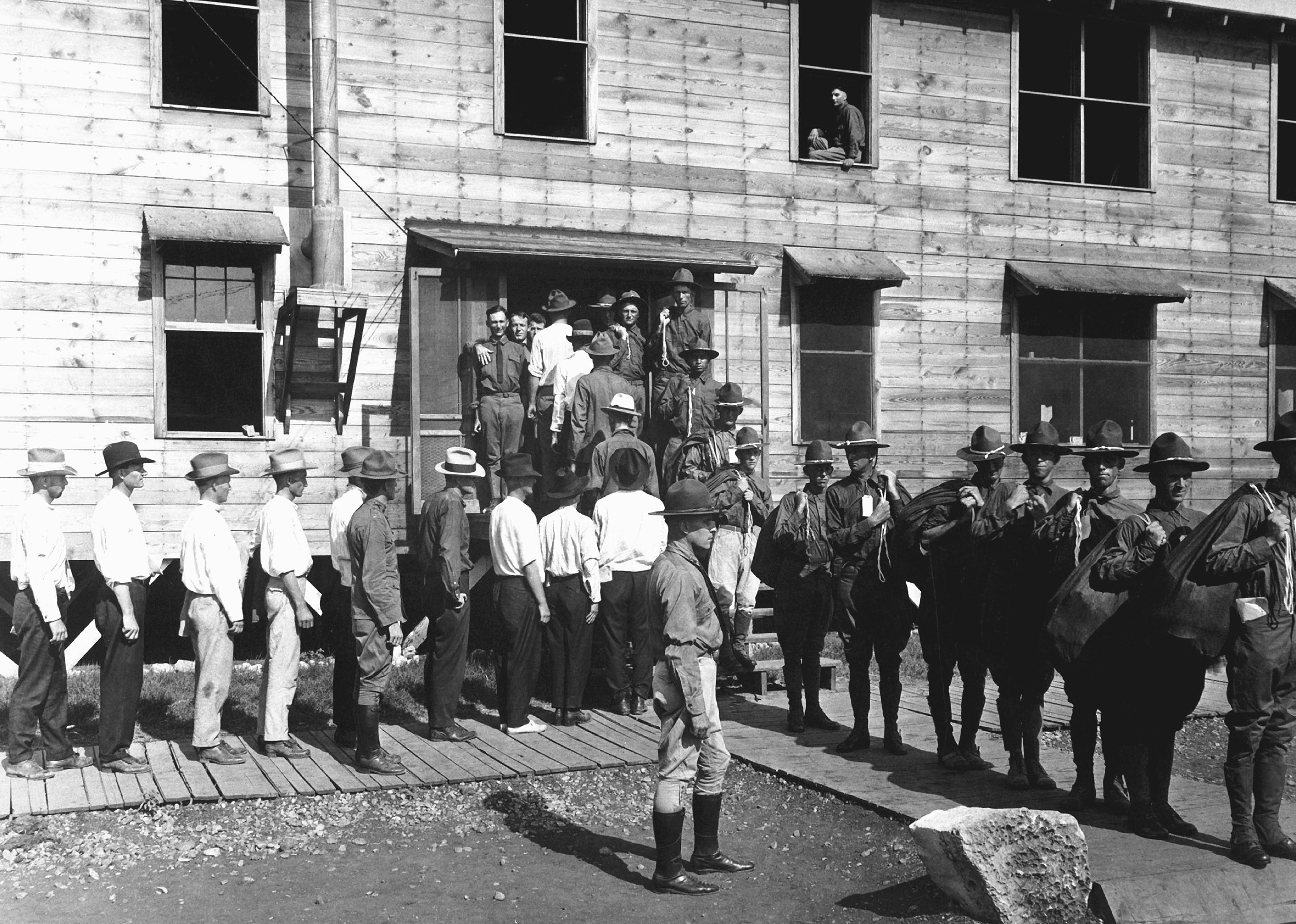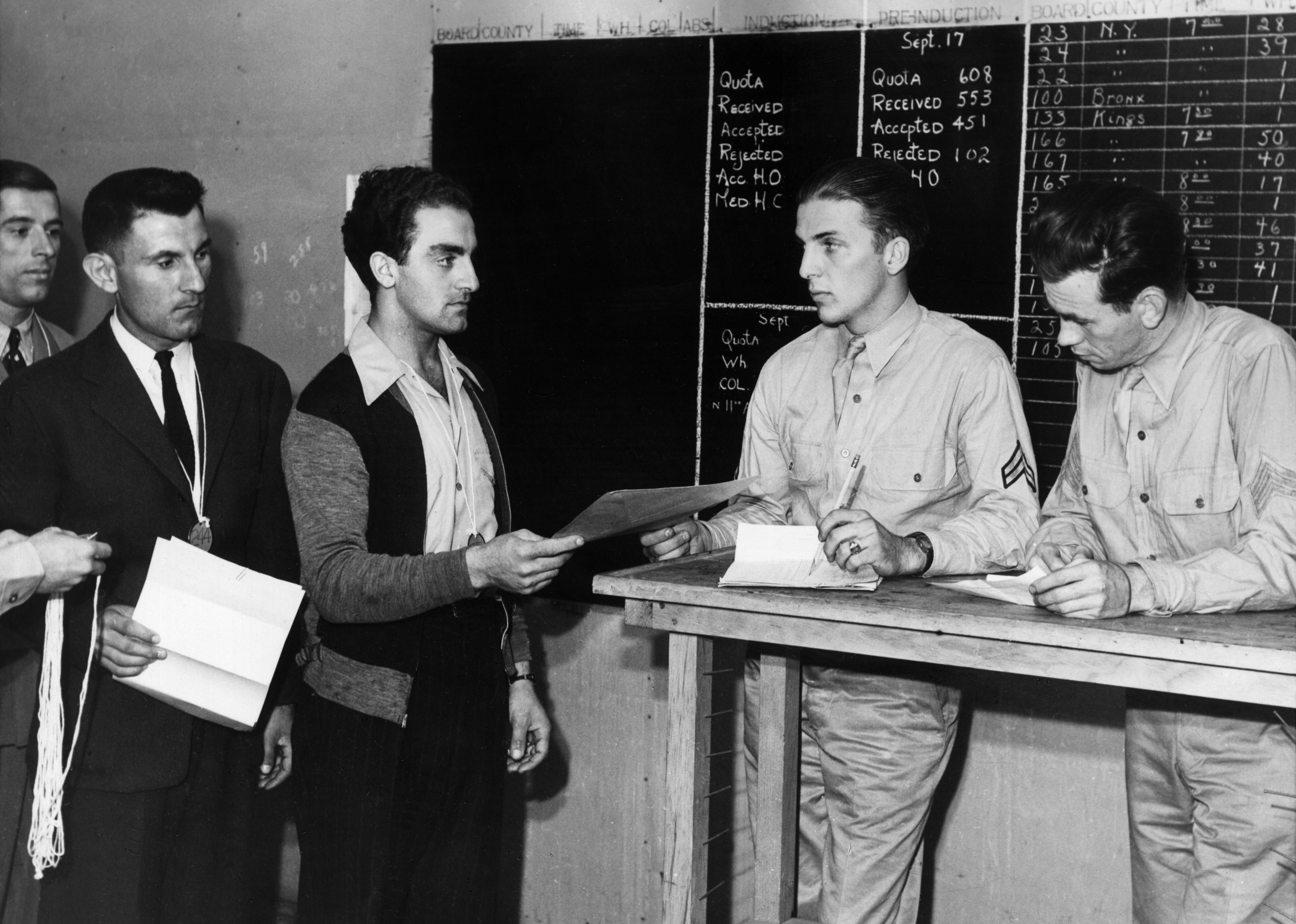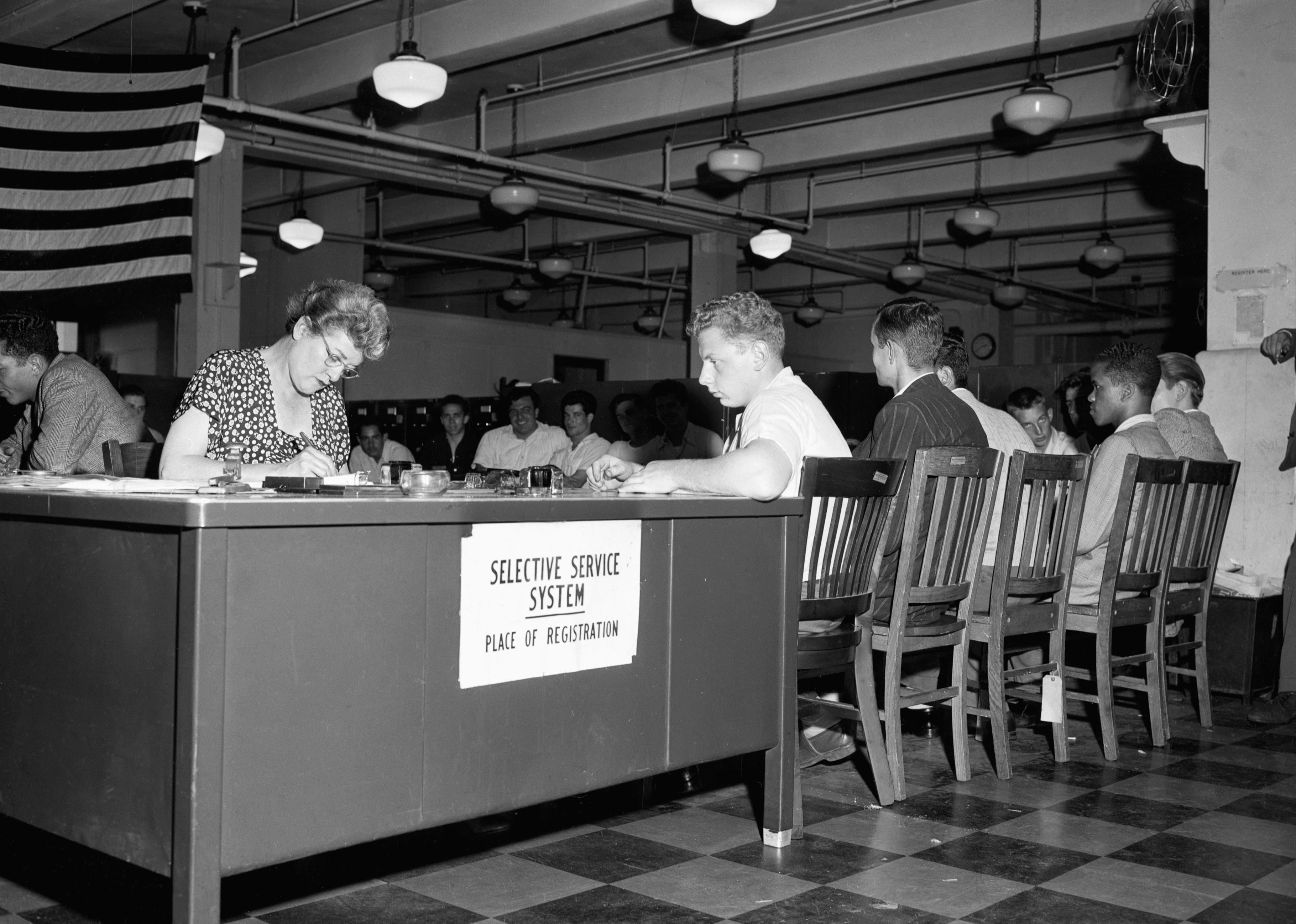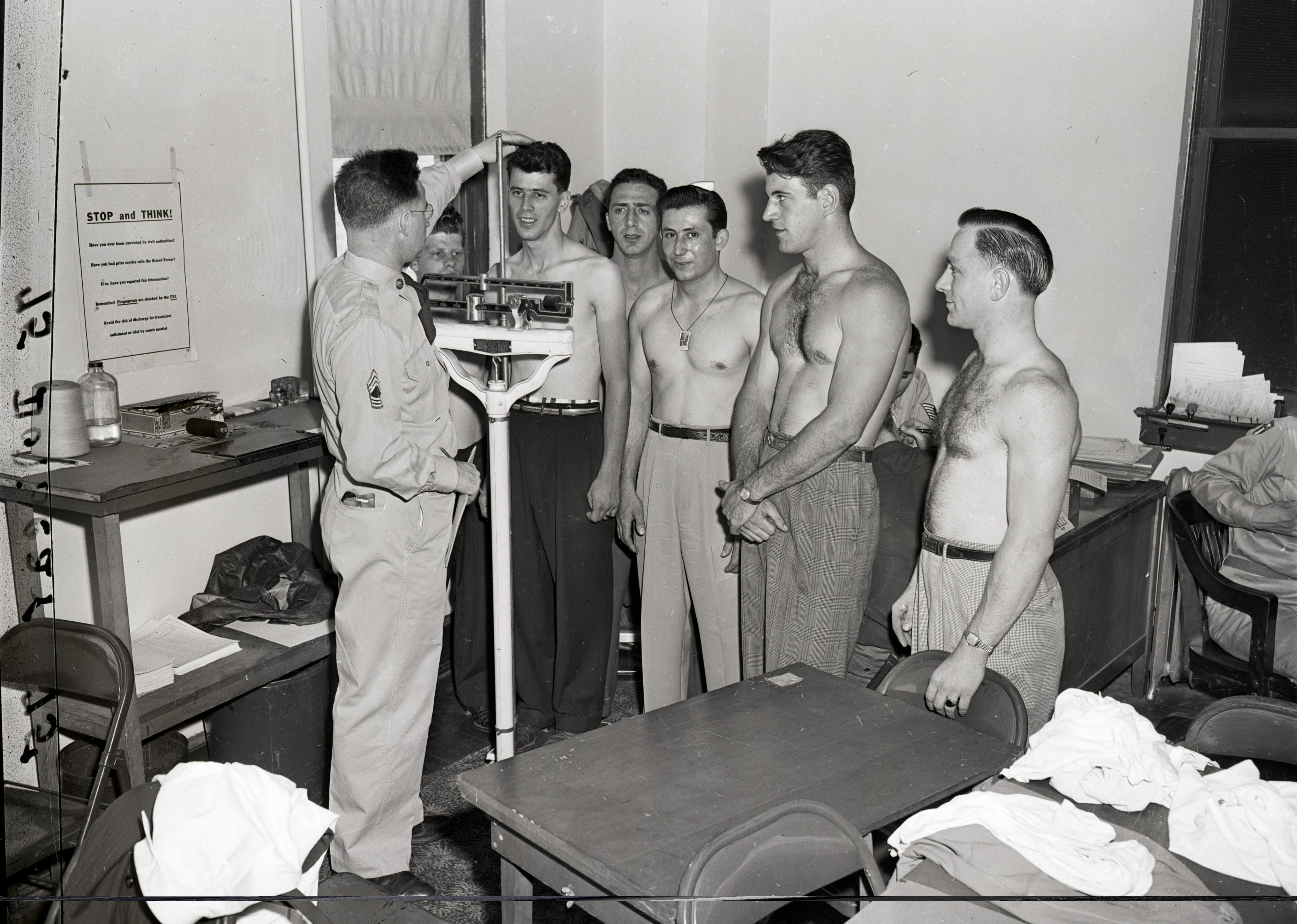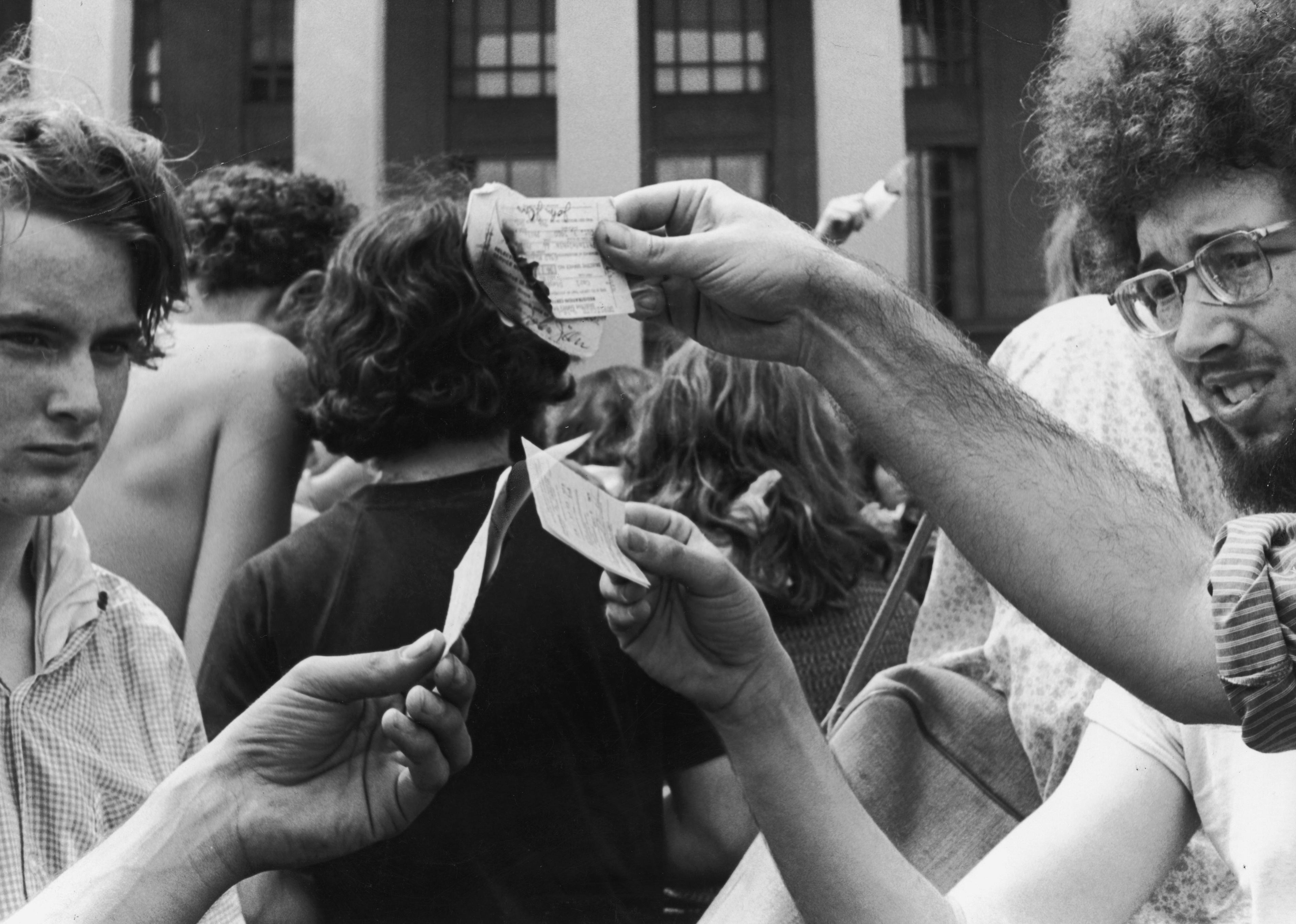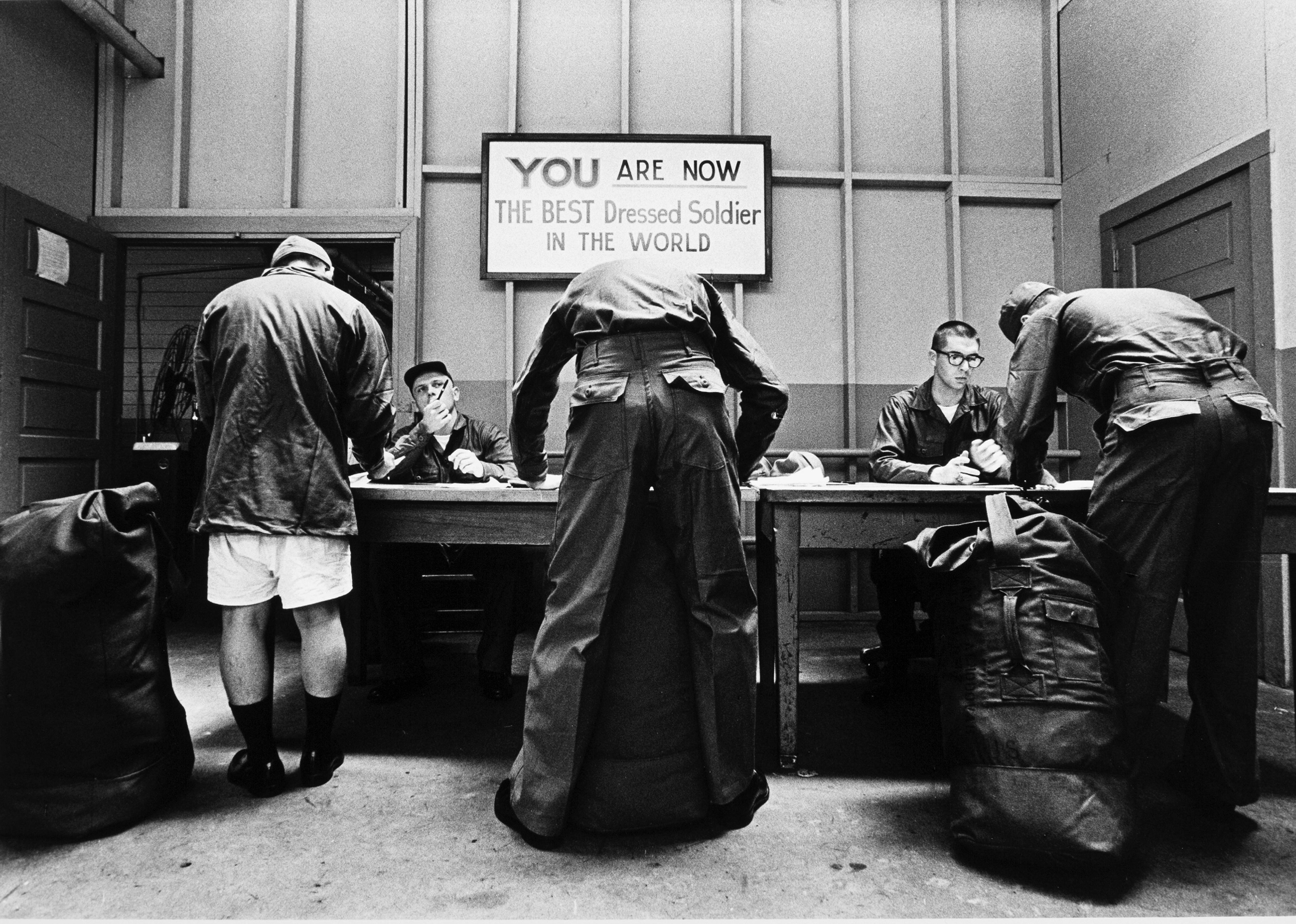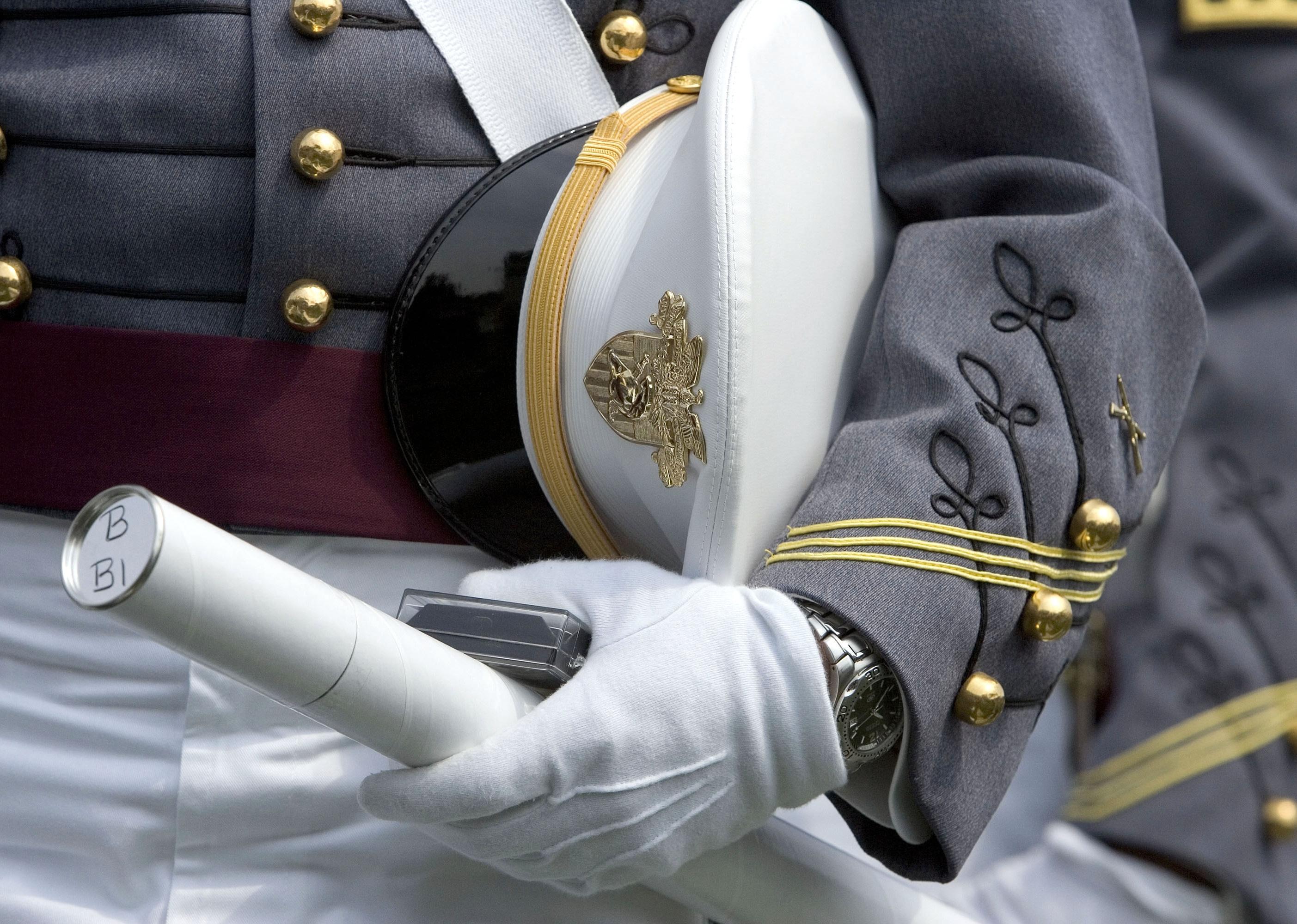A brief history of the US draft
Bettmann // Getty Images
A brief history of the US draft
Eighteen- and 19-year-old men take their oath upon entering the receiving center at Camp Upton.
On April 14, Russian President Vladimir Putin signed a draft law designed to curb dodgers of the conscription he ordered in September 2022 to boost his offensive strategy against Ukraine. That first conscription, instated just a few months into Russia’s military invasion of Ukraine, resulted in massive protests in several cities, where hundreds of people were arrested. At the same time, thousands fled the country to avoid induction.
With this new draft law, the Kremlin is resorting to electronic notifications, such as direct emails and public service webpages, to let eligible people know they have been called up for compulsory military duty. Notifications are binding as soon as they are sent. Refusal can result in dire consequences, from denied access to bank accounts to as much as a decade in prison.
It has been more than 50 years since the United States resorted to the controversial state-mandated enlistment of citizens for military training and service, and yet the draft remains alive in public memory, as do the protests against it, the escapes to Canada and Mexico, and the demonstrations of public refusal in the form of the burning of draft cards.
From the Revolutionary War to the current state of the Selective Service System, conscription has always sparked animosity among the American population, even as military service remains a steadfast and popular option for young people. The Department of Defense’s latest demographic report states that there are over 1.3 million active-duty military personnel. It is the world’s third-largest active-duty military, behind China and India. Current service members now enlist voluntarily, as vowed 50 years ago by then-Secretary of Defense Melvin R. Laird, during the signing of the Paris Peace Accords: “I wish to inform you that the armed forces henceforth will depend exclusively on volunteer soldiers, sailors, airmen, and Marines.”
Stacker compiled information on the history of conscription in the U.S. from government reports, academic archives, legislative files, and media sources to recall how draftees were summoned to serve in the military during the nation’s most critical affairs and throughout periods of subsequent peace.
You may also like: Best WWI movies of all time
![]()
Hulton Archive // Getty Images
Prior to Civil War
Minutemen facing British soldiers on Lexington Common, Massachusetts.
Before the Civil War, each colony formed its own militia with men ages 18-45, defined as “able-bodied.” During the Revolutionary War of 1775-1783, an army was formed by recruiting soldiers through cash payments and offers of free land in the West after the war was won. The strategy was unsuccessful; consequently, then-Gen. George Washington demanded the 13 colonies’ militias be conscripted to the American Patriot forces in combat against the British Army. The number of soldiers drafted is unknown.
Once president of the newborn republic, Washington tried to impose conscription, as would his successors John Adams, Thomas Jefferson, and James Madison. However, Congress did not pass any of their proposals.
Buyenlarge // Getty Images
Civil War (1861-1865)
The 6th Maine Infantry in Portland, Maine.
The discrepancy in population between the Northern states (approximately 22 million) and the Confederacy (9 million) at the outbreak of the Civil War is the primary factor that drove the first draft of the war. Knowing that it would need every able-bodied soldier in order to stand up to the greater pool of resources held by the North, the Confederacy officially began conscripting its citizens to service on April 16, 1862. All white men ages 18 to 35 were inducted for a three-year term of service, and those already enlisted were conscribed a further two years—though exceptions were made for those who were civil servants or militia officers, members of the clergy, and those who held crucial war production jobs. Later that same year, as the war deepened, the age limit was extended to 45. In 1864, the age range was altered to 17 to 50, and service periods became unlimited.
One key exception to conscription in the South was what came to be known as the “Twenty-Slave Law,” ratified on Oct. 11, 1862, allowing white men to avoid military service if they owned at least 20 working enslaved people. This caveat was a direct response to President Abraham Lincoln’s Emancipation Proclamation, given in September of that year.
Conscription in the Northern states followed soon on the heels of the moves made by the Confederacy, once it became clear that the Union’s state militia draft of 1862 was not producing the results intended. Lincoln’s official called for a draft on March 3, 1863, to begin inductions that summer.
The negative response to this announcement cannot be understated, despite the crucial need in light of the escalating war. Over the course of five days in July 1863, anti-draft protestors took control of New York City’s Second Avenue armory, halting the registration process, burning city buildings, looting stores, and attacking and killing people who refused to join the revolt. Troops stationed in Gettysburg were brought back to the city to suppress the chaos. Before tensions cooled, at least 120 people were killed—the actual tally remains contested, with some reports driving that number upwards of 1,200—and the riot stoked an underlying current of anti-Black sentiment within the Northern states, as Black people were among the primary targets of violence.
Interim Archives // Getty Images
World War I (1914-1918)
A line of civilian men, drafted for service, entering a building to report for duty and exiting in uniform.
The United States was a late entrant to the First World War, with Congress not making its war declaration against Germany until April 1917 (and then later against Austria-Hungary that December). Consequently, the Selective Service Act, initiating the nation’s first official conscription system, was not passed in anticipation of U.S. involvement, but rather a month after it began, in May 1917. Facing strong opposition, President Woodrow Wilson proposed the law anticipating that 100,000 servicemen (the army count at the time) would not be enough for the country to succeed in France.
The act required all men ages 21 to 45 to register for service. About 250,000 men failed to register on the first draw, and 50,000 applied for exemptions. Eventually, however, 2.8 million men between the ages of 21 and 31 were inducted alongside 2 million volunteers.
It was the first draft where men requested exemptions as conscientious objectors on the basis of religious and moral reasons. Those excused from bearing arms were allowed to perform noncombatant military functions.
Lawrence Thornton // Getty Images
World War II (1939-1945)
Draftees reporting for physical examination at the US induction center on Governor’s Island.
Congress passed the Burke-Wadsworth Act in September 1940. It was the first peacetime conscription legislation in U.S. history. Officially called the Selective Training and Service Act, the law required men 21 to 45 years old to sign up for the draft.
Initially, one year of service was mandatory for those inducted through the draft lottery. Nonetheless, once the country entered the war in 1941, the period of service was stretched until the war’s end.
By the time Allied forces claimed victory over the Axis powers on May 8 (V-E Day) and August 14 (V-J Day) in 1945, about 50 million American men between the ages of 18 and 45 had registered for service, and 10 million were conscripted into the armed forces. The age of the draftees was lowered as the war progressed, and conscripts were recruited by age—from oldest to youngest—though no longer through a lottery.
The change in the minimum age requirement prompted protests and a public campaign to decrease the statutory age to vote. The slogan “Old enough to fight, old enough to vote” was so widely publicized that it became the basis for the 26th Amendment, signed in 1971 by President Richard Nixon.
Bettmann // Getty Images
Cold War (1947-1991)
New York City Youths Wait seated to register for draft at 80 Lafayette Street.
In 1947, President Harry Truman recommended the expiration of the Selective Training and Service Act and suggested keeping enlistment open only to volunteers. However, as the burgeoning Cold War exacerbated fears of Communist aggression and the numbers of servicemen were low, the STS Act was replaced a year later by the Selective Service Act of 1948. It was the second draft during peacetime and created the Selective Service System.
The law, also known as the Elston Act, drafted men ages 18-26 for one year of service (though induction was delayed for 18-year-olds until they turned 19). The act was only meant to be valid for a period of two years but ended up being amended and extended 22 times. As with previous drafts, exceptions were made for certain classifications of people. Students; fathers (under particular circumstances); workers whose labor was vital to national interests, such as farmers; and conscientious objectors were granted unconditional deferments.
You may also like: 50 best American war movies
Bettmann // Getty Images
Korean War (1950-1953)
1950 New Jersey draftees take physical exam.
With the Elston Act set to expire in 1950, the onset of the Korean War urged Congress that military conscription was an essential tool for winning the war. Renamed the Universal Military Training and Service Act, the 1951 law prompted the induction of 1.5 million draftees. The Selective Service System provided 27% of servicemen during the war, among them more than 7,000 physicians and 3,800 dentists.
Based on the number of eligible men, each state was required to enlist a certain number of conscripts. Those who agreed to become permanent servicemen received financial credits as incentives. World War II veterans were offered automatic deferment. At the same time, conscientious objectors were required to serve for two years in noncombatant positions pertinent to national health and safety or other areas of public service in their communities.
Hulton Archive // Getty Images
Vietnam War (1955-1973)
Anti-war demonstrators burn their draft cards on the steps of the Pentagon during the Vietnam War.
While America was involved in the civil conflict in Vietnam from the mid-1950s, a full-scale military presence was not drawn up until the early 1960s, in the wake of the assassination of John F. Kennedy and the attack on two U.S. Naval destroyers in the Gulf of Tonkin. From 1964 to 1973, 2.2 million men were inducted into service from a draft pool of 27 million. Many conscripts complied with recruitment even though they objected to the war. Deferment requests were numerous, many alleging paternity or enrollment in college, while others deliberately underperformed in aptitude tests. Thousands of young men fled to Canada or other countries, and many others joined anti-war activist groups that categorized conscription as immoral.
Protests against the war fired up opposition to the draft. The antiwar movement began on university campuses where young people, the same age as draftees, began organizing public forums to express their objections regarding the motives behind the war.
Demonstrations gained strength in late 1965 when President Lyndon B. Johnson ordered increased air and ground attacks in North Vietnam. By 1967, the Selective Service was recruiting about 40,000 new draftees per month. In October of the same year, protests peaked when 100,000 anti-war activists met at the Lincoln Memorial in Washington D.C. Later, an estimated 50,000 marched to the Pentagon.
Conscription for the Vietnam War finally ended in January 1973 with the signing of the Paris Peace Accords.
Edmund Eckstein // Getty Images
Deep Standby
Three recently drafted soldiers sign papers under a sign that reads ‘You are the Best Dressed Solider in the World’ at Fort Jackson.
From 1969 to 1973, President Richard Nixon ordered several adjustments to conscription laws. Nixon authorized permanent exemption for young men not originally drafted at the age of 19, except in cases of national emergency. He also ordered a “random selection lottery system” instead of drafting by age and signed deferrals for certain workers, conscientious objectors, clergymen, and students. (Later, however, Nixon would reverse his position on student deferments.)
In 1970, the Supreme Court added the concept of “sincerely held ethical and moral beliefs” to the basis of conscientious objection to bearing arms or engaging in combat. The last extension of the Selective Service Act of 1967 expired in 1973, the same year the government publicly ratified the end of mandatory military service during the Paris Peace Accords.
Through Proclamation 4360, signed by President Gerald Ford on March 29, 1975, registration for military conscription was suspended, putting the Selective Service System on “deep standby,” whereby it would only become operational in cases of national emergency.
Stephen Chernin // Getty Images
Out of deep standby
A cadet holds his diploma and cap during the graduation ceremony at the U.S. Military Academy.
In 1980, the Selective Service System was reinstated with a new structure requiring all men to register with the SSS within 30 days of their 18th birthday, either in person—at U.S. post offices or diplomatic agencies—or online at the SSS website. They are liable for draft, training, and active service until age 35.
This new structure exists to this day. More than 100 people are permanently employed by the SSS.
